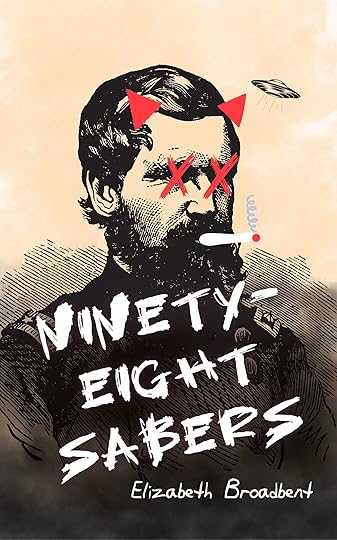Ninety-Eight Sabers Q&A
 (Note: not the actual cover)The one sentence pitch for Ninety-Eight Sabers
(Note: not the actual cover)The one sentence pitch for Ninety-Eight Sabers What if The Royal Tenenbaums took place on Skinwalker Ranch—but a plantation?
The blurbThe sprawling Nesmith clan helped found Lower Congaree, South Carolina. Problem: they’re slightly nuts. Second problem: their land is cursed, or something. Third, fourth, fifth problems: Their father/uncle was abusive; he’s dead; and only heirs who attend the funeral will inherit.
But when Truluck Nesmith suffered his eventually-fatal stroke, his oldest son Ash turned the haunted plantation wedding destination, which supports and employs their vast clan of cousins, into the site of an enormously successful reality show. Ash’s brother Sullivan and cousins Rhys and Olivia aren’t happy about it. But Rhys has student loans to pay. Sullivan and Olivia want recompense for their childhood. And their fifth cousin Henry was never supposed to come to Cypress Bend, much less stick around.
Forced to tolerate the gross intrusion of California producers, grip guys, and cameras, toting a metric ton of childhood trauma, the cousins have plenty of animosity for each other, along with a strong aversion for the paranormal shenanigans of their childhood home. But when the funeral goes fucktangular and the cousins are cut out of the will, Sullivan, Rhys, and Olivia are offered the deal of a lifetime. To take it, they’ll have to become the witchy Kardashians with a Southern drawl. They hate it. But as weird tumbles into weirder, they’ll have to come together as a family. Or else.
The inspiration for SabersShort answer:
I watch a lot of The Secrets of Skinwalker Ranch and thought, “wow, the concept of operating a plantation as a wedding destination is racist/offensive/bizarre enough. What if it was haunted?”
Long answer:
This is a true story.
In the not-so-distant past, an archivist in an unnamed Southern state found out the State Archives was junking 200 Confederate sabers. Offended, he absconded with them all. These rusty sabers were festooned through his whole house, including the bedrooms. Clearly, I had to steal this story.
Longer answer:
South Carolina has a long history of the bizarre and macabre. On the eve of secession, Charleston unionist James Louis Petigru called the state “too small for a Republic, and too large an insane asylum.” This is our unofficial state motto. The real one is “Dum spiro spero,” literally translated to “While I breathe, I hope,” and figuratively to “I tilt at windmills on a regular and persistent basis.”
We’re a banana republic masquerading as a state, really.
They always tell you to write what you know. Maybe luckily, or not, I’m intimately acquainted with a place where tapwater tastes like moss. BBQ barns fly Confederate flags; the postal service is spotty, and our senior senator’s a notable pool shark. He used to eat dinner at one of my bestie’s houses, where he found the hump in their table immediately. The former senior senator used to eat dinner there too, before he croaked. He was a Dixiecrat. Our first apartment was at the corner where a drunk driver killed his daughter, and that’s how we gave people directions to our house. “We’re the first house up from the corner where Nancy Thurmond got hit,” we’d say.
“Oh, there,” friends would reply, though Nancy Thurmond died in the arms of the South Carolina Lieutenant Governor—who happened to be passing by—years and years before.
You’d write about it, too, if only because that one downtown gas station kept a tiger. Though it was before my time, Happy the Tiger eventually became the first animal at Riverbanks Zoo, and my kids spent their formative years climbing over his statue.
Recently, state Senator Dick Harpootlian, known locally as “Poot-Poot” and Alex Murdaugh’s trial attorney, gave a speech in which he informed the General Assembly, multiple times, that if concealed weapons were allowed without a permit, the senators themselves should “strap one on.”
He knew exactly what he was saying.
We lost our governor once. He returned from what his staff hurriedly claimed was “hiking the Appalachian Trail” (they couldn’t find him either, and the FBI was worried he’d been kidnapped by a foreign power) to announce at a tearful press conference that he’d “spent five days crying in Argentina” with his mistress, a former Miss Universe. He apologized to his wife, children, the Great State of South Carolina, and the Lord.
A passing statehouse tour happened by. A Black woman stopped and watched the entire press conference, standing behind him, in full view of the media, wearing a shark-like grin.
She is my hero.
The Reverend E.X. Slave set fire to the Confederate flag in front of the Statehouse while wearing a black Santa suit (not red, just black). Like Wu Tang clan at the MTV Video Music Awards, he said he “did it for the children.”
The police peppered sprayed him. It blew back in their faces.
Judge Alex Sanders preserved the now-national park in Congaree. He said he had fake Confederate cannonballs waiting to seed the ground in case appeals to environmentalism didn’t work.
He was serious.
Westinghouse had a leak and spilled radiative chemicals in the Congaree Creek. Since they didn’t tell anyone, I swam in it, with my kids, a few months after.
The University of South Carolina voted to make its mascot the Gamecock after Revolutionary War general Thomas Sumter. They did so because they wanted to yell “GO COCKS!” at football games.
This tradition persists.
Thanksgiving is a high holy day not for the feast, but for the Carolina-Clemson game.
The state government still celebrates Confederate Memorial Day.
And on and on and on.
Here’s a way to understand the Gothic at the heart of the SouthFlannery O’Conner’s “A Good Man is Hard to Find” is a classic for a reason, but it’s a linchpin to understanding Southern literature, and not for the reasons you think. Central to any understanding of the South is the lingering morass of history, our institutional racism, corruption, cronyism, and Lost Cause-ism. We can recite it like a nursery rhyme. But there’s a detail in that story that shows the effect all of them have when taken in total.
The tired family stops for lunch at one of those ubiquitous roadside BBQ barns. They have checked tablecloths, buffet-style service, and kitschy signs like “If You Can’t Stand The Heat, Get Out Of The Kitchen” and “God Don’t Make No Junk.” The kids eat outside. They watch the monkey in the trees, and the owner tells them about a recently escaped gang of murderers.
Did you catch it? There’s a fucking monkey in the tree. The monkey belongs to the owner. He’s a resident of the BBQ Barn. The monkey’s presence is not rationalized, and the narrative continues. You want to tell about the South? There it is: the monkey at the BBQ barn. It’s that shimmer of lunacy. When you live under the yoke of insanity for long, it becomes part of the scenery. The governor goes missing. Alex Murdaugh fakes his own suicide. Lady Chablis powders her face in her own cocaine and steps onstage.
If you find yourself paralyzed between laughter, rage, and weeping, the proper response is, “Bless your heart.”
So What’s Real in Sabers?If it claims to be actual history and didn’t walk out of time portal, it happened.
What about the brutal legacy of racism?It’s real and it’s ugly.
This includes the story, which I handed to Sullivan Nesmith, about a famous Irish poet. Somehow, in graduate school, my husband and I were nominated to chauffeur Eavan Boland. Two miles from Columbia International Airport, we came upon Maurice’s Bessinger’s Piggy Park, a barbecue complex flying an enormous Confederate flag. Boland was appalled, and we were forced to explain that not only did people still eat there (I never did, despite its ubiquity, and I remain proud), but that Maurice only dropped his refusal to integrate when the Supreme Court ruled against his Biblical defense of slavery.
I also took a college class in which Cleveland Sellers spoke. The current president of Voorhees College was shot during the Orangeburg Massacre in 1968 (please read the link, which explains this forgotten chapter in American Civil Rights history far better than I could). He was subsequently jailed, incarcerated on Death Row, and only pardoned for allegedly inciting a riot twenty-five years later. I know people whose relatives were killed during that massacre, during which the National Guard opened fire on college students.
My best friend knew Clemanta C. Pinckney, who was brutally murdered by Dylann Roofe during the shooting of Mother Emmanuel Church in Charleston—he had lunch with Rev. Pinckney the week before he was killed. Roofe went to school with one of my former students. And before he perpetrated that hate crime, he cased several places in the Columbia area. This includes Finley Park, where I often took my sons to play. Allegedly, he was targeting the local Black homeless population.
My husband taught at the school Roofe’s sister attended when she as expelled for making racially motivated threats of violence.
When the good reverend burnt that flag, a passing motorist shouted, “String him up!”
This stuff is chokingly, terrifyingly real. Some people there believe Black people should still be enslaved and/or actually, literally second-class citizens. For all its humorous lunacy, for all its Gothic bizarrity, this is the central fact of the state’s existence. We live in the shadow of the Lost Cause: Dum spiro spero.
Sabers releases November 29th from Undertaker Books.It’s already gone to at least one blurber, as well as the capable hands of editor Rebecca Cuthbert. It made my best friend laugh, as well as weep. Keep checking this substack for updates, and in the meantime, write on!
Thanks for reading Feral Swamp Life! Subscribe for updates, mayhem, etc.
for free to receive new posts, mayhem, and mischief.



